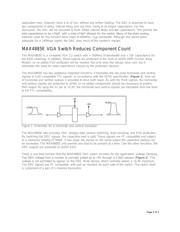herunterladen

Maxim > Design Support > Technical Documents > Application Notes > Analog Switches and Multiplexers > APP 4371
Keywords: Switching VGA Signals, VGA switching, Notebook Applications
APPLICATION NOTE 4371
Switching VGA Signals in a Notebook
Mar 23, 2009
Abstract: This application shows how the MAX4885E low-capacitance VGA switch can be used to
perform the switching function between a notebook computer and a docking station. The MAX4885E
draws nearly zero current, fits into a 4mm x 4mm package, and incorporates most of the switches and
active components used in a discrete implementation. The device thus saves costs and component count
in the application. All device outputs are protected to ±15kV Human Body Model (HBM).
Introduction
Although digital video switching has become more popular in 2008, there are still tens of millions of
monitors and projectors that dictate the use of analog VGA support until at least 2015. Nearly all
enterprise notebook computers, which employ a docking station, switch VGA signals through a set of
connectors at the base of the notebook.
An ideal device to handle the switching between the dock and the VGA connector manages all the
switching and has adequate ESD protection for all outputs connected to a port connector.
The MAX4885E VGA switch is optimized for signal switching between a notebook and docking station.
The device contains three very high-frequency (~950MHz) switches for RGB, two low-frequency
clamping switches for the DDC signals, and a pair of level-translating buffers for the horizontal and
vertical signals.
Optimized VGA Switching
To handle the analog VGA signal properly, the seven signals should be routed either to the rear
connector on the computer or to the docking port. If this function is not switched, either port could be
connected while not in use, thus adding considerable capacitance to the DAC and causing bandwidth to
roll off. Video signals are usually standardized to 75Ω impedance, and the video DAC is normally a
current source driving a 75Ω load. The monitor is a 75Ω load as well, providing for a doubly terminated
system. Maximum output of the DAC into a 75Ω load is 0.7V for VGA.
Many designers try to achieve 1920 x 1200, 60Hz, which yields a pixel rate of ≈6.0ns. If we permit a rise
and fall time of 1.7ns (each), the signal will pass the VESA (Video Electronics Standards Association)
requirements. Therefore:
t
R
= 2.2RC, where R = 37.5Ω
This equation would yield the t
R
for the system, if the DAC had a t
R
of 0. A typical DAC for this
Page 1 of 3
Verzeichnis
- ・ Blockdiagramm on Seite 2 Seite 3
- ・ Anwendungsbereich on Seite 1





